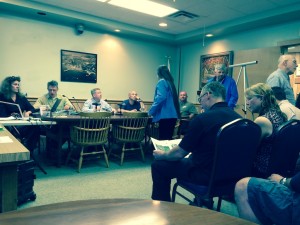The Mattapoisett Conservation Commission has seen some very long meetings, but the June 8 session rivaled all others. Starting on time at 6:30 pm, it was after 10:00 pm when they finally wrapped up, causing one resident who had waited the entire evening to speak to the commission to announce, “It is now an hour and a half past my bedtime, so I’ll have to address you from my written notes,” not wishing to trust his memory.
The hearing that inspired the lengthiest discussion was the remediation and restoration plan offered by Daniel and Lisa Craig, 4 Seabreeze Lane, in their Notice of Intent filing.
Representing the Craigs, Brandon Feneuf, president and founder of Ecosystem Solutions, Inc., explained in finite detail the proposed compromises the Craigs were willing to offer the town to compensate for encroaching into the ‘no touch zone,’ and for exceeding permitted lawn space from 10,000 to nearly 22,000 square feet in this subdivision.
What Craig offered was restoration of 992 square feet of wetlands within the buffer zone and an additional 12,334 square feet of lawn to be returned to a more natural state. But the members of the commission were conflicted on how they could accept the plan.
In 2007, Craig was issued a Certificate of Compliance. However, at that point in time, the manicured lawns had not been planted. The property was comprised of uplands and wetlands vegetation, the majority of which was to have remained in its natural state as per the agreement the developer had with the town and with the Buzzards Bay Coalition.
Speaking on behalf of the BBC, Korrin Petersen, senior attorney stated, “The coalition wants to see all lawn turned over once and seeded with native plantings and return of the 75-foot no touch zone.” She pointed out that Craig’s plan only returns 59 percent of altered area to a more natural state instead of 100 percent, saying, “It sets a bad precedent for the town.”
Petersen told the commission that only 10,000 square feet was originally approved for lawn area for all parcels in the subdivision, but the Craigs had exceeded that. In addition, information on the septic system had not been received and the stormwater swales needed to be restored.
Commission members Peter Newton and Tom Copps said they were unwilling to overturn a previous board’s restrictions and were not comfortable with the plan.
“They may go to the DEP,” said commission member Mike King. “[The] DEP may see this as a reasonable plan.”
Newton countered, “I need more time to wrestle with this, but we shouldn’t make our decisions based on fear of the DEP.” He continued, “We have a state law we are obligated to uphold. Where do we draw the line? Isn’t it easier for everyone to say the line is the line?” He made the point that all applicants and applications were dealt with equally with the implementation of the Wetlands Protection Act.
Resident Cheryl Belknap, 34 Fairhaven Road, asked, “Why do we have rules if people are allowed to come in and ask for forgiveness later?” Chairman Robert Rogers replied, “We do the best we can, that’s all we can do – it’s always a negotiation.”
Belknap also said that an easement exists on the Craigs’ property to allow all the homeowners in the subdivision access to the water, but, over time, the shell path had been removed.
Feneuf was asked to return on June 22 after conferring with his clients to determine what the next steps might be in trying to resolve how much of the Craigs’ property will be returned to its original condition, which types of plants to be used, and other considerations.
In other business, the continued hearing for the private pier proposed by Jay and Julie Duker of 112 Aucoot Road met with another series of questions and concerns from both the commission and residents.
Doug Schneider of N. Douglas Schneider & Associates explained to the commission that the pier construction had changed since the previous hearing due to the discovery of sub-surface ledge. He now proposed a combination of pilings and steel rods driven into the bedrock to support the extended expanse.
But it was the movement of the barrier beach that had the commission and resident Brad Hathaway concerned about the wisdom of the construction.
Hathaway said, within the last year, the beach has moved 30 feet and, in recent years, as much as 100 feet. He said that if a storm came through a breach in the barrier beach, it could leave the pier unreachable, rendering the structure useless. He supported his concerns by adding, “There are five piers in Mattapoisett to the south and none of them are in the sand flats.” He continued, “What has happened – barrier beaches used to be sacrosanct!”
The application was continued until June 22 at which time Schneider will return with answers regarding shearing potential of the metal rods and a full performance report for the pier itself.
The next meeting of the Mattapoisett Conservation Commission is scheduled for June 22 at 6:30 pm in the Mattapoisett Town Hall conference room.
By Marilou Newell
